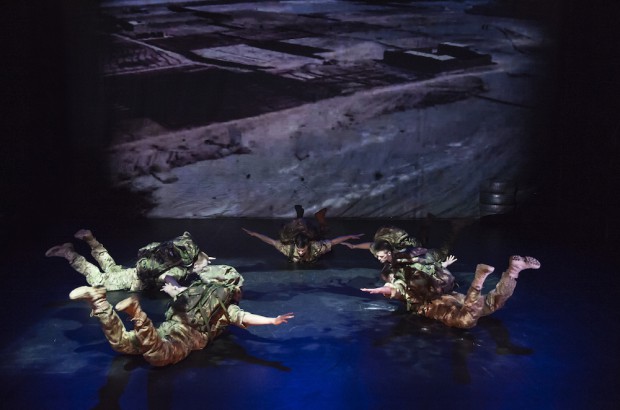In dance, it’s usually the moment the boys start fighting that challenges your suspension of disbelief. Synchronised fencing (MacMillan’s Romeo and Juliet), unison goosestepping (Grigorovich’s Spartacus), even the Sharks and Jets in Robbins’s West Side Story, are formation set-pieces designed to arouse us. Last year there was a bunch of ballets made by British choreographers to mark the first world war centenary, which artfully focused on sorrow.
But high tension, apprehensiveness, emotional denial — what’s really in the fighter’s head — these are physically antipathetic to dance’s expansive language. This is why Rosie Kay’s 5 Soldiers: The Body is the Frontline is so powerfully striking and bold a dance work. If you were told that these were actually five British soldiers reliving daily experiences, you would at first believe it, so brutishly physical is their long opening sequence of quick marches and repetitious exercises through imagined enemy territory.
There is nothing in the least entertaining about it. Sweat pours down their faces. Real truck tyres are chucked. Muscles bulge in tight necks and slammed-down shoulders. Where the work takes off with such imagination is in Kay’s intuition that the deepest conflict is where the enemy is not visible.
In most theatrical dance, the foes face each other. For today’s soldiers, her 70-minute piece sets out, there is no opponent to focus on. The IEDs are underfoot, the snipers are hidden. We watch these soldiers go on patrol, darting and circling in rigid formations that make a constant revolution, looking on all sides for the enemy, skydiving into who knows where.
To make a presence of the invisible enemy gives the experience a hint of that gothic darkness of the old folk tales, where men went out into a supernatural world to face the unknown, essentially within themselves. The punishing drills that Kay choreographs (she worked with army units for two years), the visual and sonic atmosphere of computer coordinates and alienating shouts of ‘You’re dead’, all seem aimed to obliterate emotions as much as to drill trigger-sharp bodies.
One of the five soldiers is female, and there is an eyewatering sequence in which the woman who has been indistinguishable in the dusty boot drills takes off her camouflage kit down to her smalls and begins to powder herself dry — openly and sensually languid — while we hear Katy Perry’s ‘Firework’ (‘Come on, let your colours burst, make them go ah-ahah’). In a poetic rewrite of the razor-wire crawls and military kicks of the soldiering, she slithers softly in her powder and repeatedly splits her legs in her colleagues’ staring faces.
It is surely the men’s fantasy that this gorgeous blonde amazon (mesmerising Shelley Eva Haden) is the girl, the mother, the Britannia, that they’re all fighting for. But you do also sense the female soldier’s need to reassure herself, in private, that she remains herself in this bleakly aggressive world.
And how can a soldier remain himself if maimed? Is suffering and awareness more human than locked-down, Action Man objectivity? This is the tough climax Kay is building to. Oliver Russell delivers two outstanding solos, one on stumps of legs, but his is just one of five exceptional performances in this very powerful work.
I thought of another intuitive female choreographer, Crystal Pite, and her formidable understanding of group mentality in last year’s Polaris, when I was watching Alexander Whitley’s The Murmuring on the BalletBoyz’s current touring double bill. Whitley’s piece is inspired by the flockings of starlings, but still it’s about boys on the march again.

A repeated motif is the way that attempts to take the lead are quickly held back by the others, in V-shaped clumps that slightly (unhappily) resemble Kate Winslet and Leonardo DiCaprio on the prow of the Titanic. Like Kay’s work, Whitley’s has a man going to pieces in it, but the broadly athletic, tumbling activity doesn’t quite fly as dance — the thoughts remain too tentative.
Still, coupled with Christopher Wheeldon’s more lucid Mesmerics, this is an evening worth seeing. The all-maleness of the BalletBoyz’s Talent team provokes new thoughts about weight exchanges from choreographers accustomed to male–female ballet dynamics of differences. That’s not merely a procedural matter — from the mechanical adjustments can come new imagination.
Here Wheeldon — a choreographer who tends to put his ballerinas on a pedestal — has found a smooth equilibrium between men that echoes, if with more milk in, the original BalletBoyz. William Trevitt and Michael Nunn (now retired) remain, in my experience, the only two men who could dance combat balletically, and make you feel it in your nerve-ends.






Comments